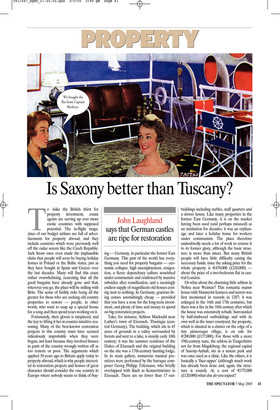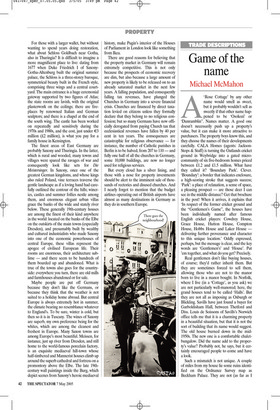Is Saxony better than Tuscany?
John Laughland says that German castles are ripe for restoration
To slake the British thirst for property investment, estate agents are serving up ever more exotic countries with supposed potential. The in-flight magazines of our budget airlines are full of advertisements for property abroad, and they include countries which were previously well off the radar screen like the Czech Republic. Jack Straw once even made the implausible claim that people will soon be buying holiday homes in Poland or the Baltic states, just as they have bought in Spain and Greece over the last decades. Many will find this craze rather overwhelming, reasoning that all the good bargains have already gone and that, wherever you go, the place will be milling with Brits. The sense of futility risks being all the greater for those who are seeking old country properties to restore — people, in other words, who want to snap up a special house for a song and then spend years working on it.
Fortunately, their gloom is misplaced, and the key to lifting it lies in counter-intuitive reasoning. Many of the best-known restoration projects in this country must have seemed ridiculously improbable when they were begun, not least because they involved houses in parts of the country wrongly written off as too remote or poor. The arguments which applied 30 years ago to Britain apply today to property abroad, which is why people interested in restoration projects and houses of great character should consider the one country in Europe where nobody seems to think of buy ing — Germany, in particular the former East Germany. This part of the world has everything you need for property bargains — economic collapse, high unemployment, emigration, a fierce dependency culture nourished under communism and reinforced by massive subsidies after reunification, and a seemingly endless supply of magnificent old houses costing next to nothing. In Germany, gracious living comes astonishingly cheap — provided that you have a nose for the long-term investment, and plenty of time and money to spend on big restoration projects.
Take, for instance, Schloss Marksuhl near Luther’s town of Eisenach, Thuringia (central Germany). The building, which sits in 45 acres of grounds in a valley surrounded by forests and next to a lake, is mainly early 18th century; it was the summer residence of the Dukes of Eisenach and the original building on the site was a 17th-century hunting lodge. In its main gallery, numerous musical premières were performed by the baroque composer Georg Philipp Telemann, who briefly overlapped with Bach as Konzertmeister in Eisenach. There are no fewer than 17 out buildings including stables, staff quarters and a dower house. Like many properties in the former East Germany, it is on the market having been used (and perhaps misused) as an institution for decades: it was an orphanage and later a holiday home for workers under communism. The place therefore undoubtedly needs a lot of work to restore it to its former glory, although the basic structure is more than intact. But many British people will have little difficulty raising the necessary funds, since the asking price for the whole property is €470,000 (£320,000) about the price of a two-bedroom flat in central London.
Or what about the charming little schloss in Nohra near Weimar? This romantic manor house with Mannerist features and turrets was first mentioned in records in 1287; it was enlarged in the 16th and 17th centuries, but there was a fire in the 18th century after which the house was extensively rebuilt. Surrounded by half-timbered outbuildings and with its own well in the inner courtyard, the property, which is situated in a cluster on the edge of a tiny picturesque village, is on sale for €200,000 (£137,000). For those with a more 19th-century taste, the schloss in Tangerhütte not far from Magdeburg, the regional capital of Saxony-Anhalt, sits in a nature park and was once used as a clinic. Like the others, it is basically a ‘fixer-upper’ (although much work has already been done and, again, the structure is sound). At a cost of €175,000 (£120,000) what else do you expect? For those with a larger wallet, but without wanting to spend years doing restoration, what about Schloss Goldbach near Gotha, also in Thuringia? It is difficult to imagine a more magnificent place to live: dating from 1677 when Duke Friedrich I of SaxonyGotha-Altenburg built the original summer palace, the Schloss is a three-storey baroque, symmetrical beauty built in the French style, comprising three wings and a central courtyard. The main entrance is a huge ceremonial gateway supported by two figures of Atlas; the state rooms are lavish, with the original plasterwork on the ceilings; there are fireplaces by renowned Italian and German sculptors; and there is a chapel at the end of the south wing. The castle has been worked on repeatedly and sensitively during the 1970s and 1980s, and the cost, just under €3 million (£2 million), is what you pay for a family house in Kensington.
The finest areas of East Germany are probably Saxony and Thuringia. In the latter, which is rural and wooded, many towns and villages were spared the ravages of war and consequently look like sets for Die Meistersinger. In Saxony, once one of the greatest German kingdoms, and whose kings also ruled Poland, vine terraces traverse the gentle landscape as if a loving hand had carefully outlined the contour of the hills; wineries, castles and summer follies nestle among them, and enormous elegant urban villas grace the banks of the wide and stately river below. These generally 19th-century houses are among the finest of their kind anywhere in the world: located on the banks of the Elbe on the outskirts of the main towns (especially Dresden), and presumably built by wealthy and cultured industrialists who made Saxony into one of the economic powerhouses of central Europe, these villas represent the apogee of civilised European life. Their rooms are enormous, their architecture sublime — and there seem to be hundreds of them boarded up and abandoned. What is true of the towns also goes for the countryside: everywhere you turn, there are old mills and farmhouses abandoned or for sale.
Maybe people are put off Germany because they don’t like the Germans, or because they think that the weather is not suited to a holiday home abroad. But central Europe is always extremely hot in summer, the climate bearing no resemblance whatever to England’s. To be sure, winter is cold, but then so it is in Tuscany. The wines of Saxony are superb, my own preference being for the whites, which are among the cleanest and freshest in Europe. Many Saxon towns are among Europe’s most beautiful. Meissen, for instance, just up river from Dresden, and still home to the world-famous porcelain factory, is an exquisite mediaeval hill-town whose half-timbered and Mannerist houses climb up around the superb cathedral and fortress on a promontory above the Elbe. The late 19thcentury wall paintings inside the Burg, which depict scenes from Saxony’s heroic mediaeval history, make Pugin’s interior of the Houses of Parliament in London look like something from Ikea.
There are good reasons for believing that the property market in Germany will remain extremely competitive. This is not only because the prospects of economic recovery are dim, but also because a large amount of new property is likely to be released on to an already saturated market in the next few years. A falling population, and consequently falling tax revenues, have plunged the Churches in Germany into a severe financial crisis. Churches are financed by direct taxation levied on citizens unless they formally declare that they belong to no religious confession; but so many Germans have now officially derogated from paying Church tax that ecclesiastical revenues have fallen by 40 per cent in ten years. The consequences are catastrophic for religious observance — for instance, the number of Catholic parishes in Berlin is to be halved, from 207 to 110 — and fully one half of all the churches in Germany, some 10,000 buildings, are now no longer used for religious services.
But every cloud has a silver lining, and those with a nose for property investments should be alert to the imminent sale of thousands of rectories and disused churches. And I nearly forgot to mention that the budget airlines operating out of British airports have almost as many destinations in Germany as they do in southern Europe.




























































 Previous page
Previous page